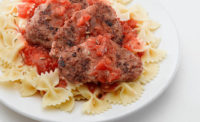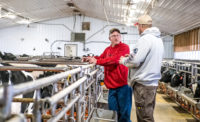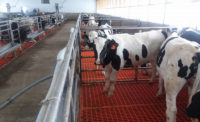Members of the American Veal Association (AVA) continued their efforts this year in sharing their farm stories with others to learn how veal is raised today. As 2019 started, AVA released new videos on their website including one titled, “Meet America’s Veal Farmers.” Opening the barn doors, so to speak, has been a meaningful way for those interested in knowing how their food is produced to see firsthand the significant changes that have occurred in veal farming.
“I’ve been eating veal for as long as I can remember. To me, veal is incredibly delicious albeit often misunderstood,” says food writer Paula Jones of Bell 'alimento. “I’m so excited to share what I personally experienced and learned. What struck me the most is how large these animals are. They are about 500 pounds at 22 weeks at market. That is a large animal.”
State of the Industry 2019
OverviewBeef (NCBA)
Pork
Chicken
Food Safety
Packaging
Beef (CAB)
Turkey
Veal
Lamb
Animal Welfare
Seafood
Workforce
Watch the 2019 State of the Industry Webinar
Register for free today!
Jones was part of a group of seven digital influencers who toured AVA member farms in Pennsylvania and Indiana in June. The tour was funded by the Beef Checkoff, and Jones’ observation was like others on the tour.
“The culture surrounding raising veal calves has been a taboo subject for as long as I can remember,” the Windy City Dinner Fairy wrote in her blog post about the tour. “I’m here today to tell you that veal calves are humanely raised and are actually a sustainable aspect of the dairy industry.”
Veal farmers knew a decade ago there was a better way to raise and care for milk-fed veal calves. The AVA established a goal in 2007 to move completely to group housing over a 10-year period. By the end of 2017, AVA member companies made that happen by investing more than $150 million in new facilities and building renovations. Today, there are a variety of facilities to house veal calves in groups ranging from as few as two up to groups of 10 or more. These facilities allow for the Five Freedoms of Animal Welfare, which is the international standard for assessing expression of normal behavior in animals. All pens enable calves to stand, stretch, lie down, groom themselves and socialize with other calves.
Individual care for healthy calves
What is sometimes missed in the conversation about group housing is that as newborns, veal calves need individual attention and that means individual pens. And here’s why this is so important: Dairy calves are born without any immunity to fight off disease. They are completely dependent on the absorption of maternal antibodies from colostrum (the first milk from a cow) after birth. That makes these young calves very susceptible to disease early in life, just like a human baby. That explains why veal calves are raised in individual pens for about eight weeks before they are moved to the group pens. This allows the farmer to give each calf a safe, comfortable, clean environment where they have access to their own feed and water, without competition from other calves and, most importantly, prevent exposure to disease risks from calves that come together from multiple farms. Once their immune systems mature, they can handle being in groups of two or more calves.
AVA members will continue this commitment of raising healthy animals by providing high standards of animal care. As individual companies and farms, as well as an association, we fully support the standards outlined in the Veal Quality Assurance program. The Beef Checkoff-funded program provides educational resources and Best Management Practices to ensure every veal farmer, and those who care for veal calves, meet the obligations and responsibilities inherent to raising animals for food. All AVA members participate in the program. Re-certification is required every three years.
Nutritious and versatile
The Beef Checkoff-funded veal promotion programs, managed by the North American Meat Institute (NAMI), focus on increasing demand for veal with current customers and creating a position for veal with the Millennial demographic and channel decision makers. Culinary inspiration for home cooks can be found on the www.VealMadeEasy.com website. The site includes recipes, nutrition information and cooking videos.
Amidst all the interest in meat, specifically adding protein to the diet, we want consumers to know veal is a great option for adding protein as well as B vitamins and Zinc to their diet. It also delivers a commitment on animal welfare and sustainability, which are two areas of transparency that may lead consumers to choose one meat product over another. NAMI’s 2018 Power of Meat report stated that production attributes have a much greater impact on Millennials’ likelihood to purchase than Boomers’.
We believe consumers’ desire to know more about how their meat is raised is an opportunity for veal. Besides being humanely raised in group pens with no tethers, castration, dehorning and tail docking are not practiced in the production of milk-fed veal calves. Calves also receive an all plant-based grain diet and are never given hormones, which are prohibited in veal production in the U.S. Antibiotics are used judiciously and only when needed as prescribed by a licensed veterinarian.
AVA-member companies embrace complete traceability of each calf from the dairy farm to the packing plant. That ensures that any questions or issues related to a calf, its health and ultimately the quality of the meat it provides, can be traced directly back to the source.
There are approximately 500 farm families that raise milk-fed veal in the U.S. The primary states where veal is raised include New York, Pennsylvania, Ohio, Indiana, Wisconsin and Michigan. NP






Report Abusive Comment